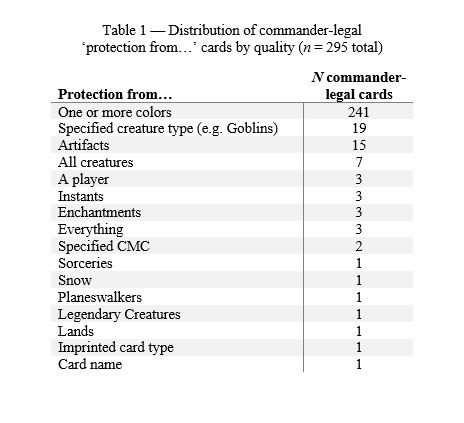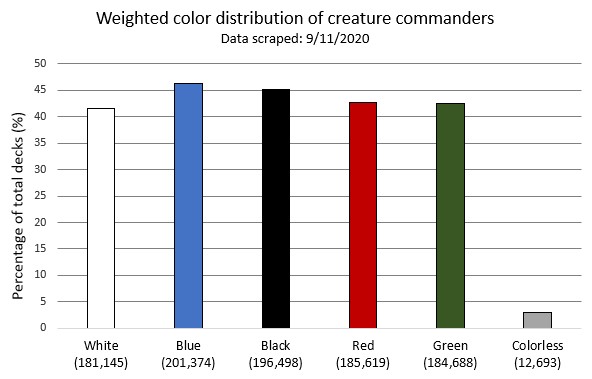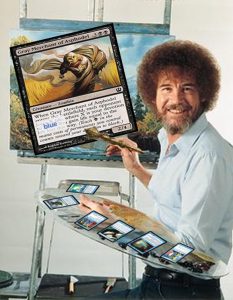(Spectra WardSpectra Ward | Art by Ryan Alexander Lee)
Shields Up!
Greetings sleuths, saboteurs, skulkers! Welcome to another installment of Evasive Maneuvers, where we examine keywords and strategies that help get our creatures through during combat.
This week we'll be taking a look at none other than: protection. Originally developed in Alpha, the mechanic is about as old as Magic: the Gathering, itself. Unlike our previous keywords like Fear, Flanking, Horsemanship and Shadow, which racked up high Storm Scale numbers, protection is a keyword that is considered deciduous, which, other than invoking some tree- or tooth-related metaphor, means it's bound to show up every once in a while.
The future of protection is best left to Mark Rosewater, who stated in his June 24, 2019 article about Core Set 2020:
I'm not quite sure about the future of protection, but it seems to be on one of two paths—either a return to evergreen status or a staying deciduous but with a heavier use in Standard-legal sets.
The big question remains: what does protection, a mechanic with a defensive connotation, have to do with evasion?
Mechanically speaking, protection has more to do than just shielding one's self. In fact, any fellow college or grad student such as myself will have an easy time remembering the acronym for how protection works: D.E.B.T. Creatures with protection from [quality] cannot be:
- Damaged by sources with the specified quality
- Enchanted/Equipped by sources with the specified quality
- Blocked by creatures with the specified quality
- Targeted by spells or abilities with sources of the specified quality
Normally, I'm a big advocate for removing silent letters, even against historical etymology, but in this case, that silent B is just what we care about.¹ We'll be diving headfirst into that very letter that dashed children's hopes and dreams at their first ever spelling bee.
¹English unabashedly continues to hold on to its silent letters. Without a doubt, I think it’s pretty dumb.
The Best Offense Is a Good Defense
Little did I know that this maxim of many (all?) of my childhood soccer coaches would have turned out to be true. We can use protection offensively so long as the defending player has the qualities our protection specifies. Like Achilles having protection from non-ankle-aimed projectiles, he's able to use that offensively against big bad Boagrius.
Of course, protection is also a fantastic mechanic for exactly what it indexes: protection. Committing to the board in EDH is always a risk, and protection effects help to mitigate against so much of the potential issues those of us who like to play with our cards face up (okay, and you Morph tribal folks) might encounter. It pulls double duty for us here, which is a big advantage.
Protection in Perspective
While not as insular as other keywords like Shadow, protection is generally quite specific in the quality it grants. Outside of something like ProgenitusProgenitus or HexdrinkerHexdrinker — who have no ankles that went un-dipped in the River of Styx like their Haktos the UnscarredHaktos the Unscarred counterpart and therefore have protection from everything — most instances protection are accompanied by a specific quality.
Given the variability of protection in specifying a quality, it's best to start by characterizing what types of protection are at our disposal. Here's what we get:
 Notably, some of the cards overlap between categories (e.g. Devoted CaretakerDevoted Caretaker gives protection from instants and sorceries, despite me separating them heuristically). Generally speaking, though, the vast majority of protection cards care about colors.
Notably, some of the cards overlap between categories (e.g. Devoted CaretakerDevoted Caretaker gives protection from instants and sorceries, despite me separating them heuristically). Generally speaking, though, the vast majority of protection cards care about colors.
Anyone who has faced against an Animar, Soul of ElementsAnimar, Soul of Elements deck knows that having access to a combo machine/Eldrazi coupon with protection from 20% of the color pie can feel pretty frustrating. Given the majority of cards with protection care about colors, let's focus on that a bit.
Well, Color Me Surprised
Similar to when we looked at Fear/Intimidate, we need to understand how the colors of our opponents' commanders may pose a problem for us; in this case, as potential blockers. By summing the total number of decks for each non-planeswalker (since they can't block) commander from EDHREC, we can then see how the weighted proportion of each color stacks up to the overall number of decks scraped by EDHREC. Doing so gives us a pretty good picture of what the color distribution of any given commander is that we might face. Here are the results:
This means having protection from blue will allow you to get past the commander of some ~46.26% of decks scraped by EDHREC. Having protection from red will allow you to slip past and go un-targeted by ~42.64% of commanders scraped by EDHREC, etc.
As for the colors of the top 100 creatures weighted by number of decklists, we see the breakdown is:
Unsurprisingly, green continues to boast the highest density of creatures, meaning protection from green is likely to go quite a long ways.
I want to caution that color here is not the same as color identity. Kor FirewalkerKor Firewalker, though having protection from red, can still be blocked by Bosh, Iron GolemBosh, Iron Golem because he is colorless, despite having a red color identity. In the case of protection from [color(s)], its best to treat that colorless bar, small as it may be, as an additional set of potential blockers.
For our purposes, protection is almost the inverse of Fear/Intimidate, which are hampered by opponents having access to more colors, as they are more likely to be blocked. Protection benefits from opponents having more colors — the more colors that your opponents' creatures have, the more likely that your protection from a given color will work. As an example: Bellowing TanglewurmBellowing Tanglewurm can be blocked by Korvold, Fae-Cursed KingKorvold, Fae-Cursed King, while BlightbeetleBlightbeetle cannot (plus, BlightbeetleBlightbeetle will prevent a lot of Korvold, Fae-Cursed KingKorvold, Fae-Cursed King's ridiculous bloating from doing something as simple as cracking an Evolving WildsEvolving Wilds).
The downside is: the color distributions of commanders are relatively even. How do we ensure our Knight of GloryKnight of Glory won't just be useless if no one is running the color of necromancy? I'll tell you how: grab your paint brushes.
Playing with Pigments
As any aspiring alter-ist or even Jumbo Commander's DJ will tell you: if you can't match the original paints, add your own. We'll be taking a similar approach with color-'hack'ing effects. 'Hack' decks use color-changing effects such as Sleight of MindSleight of Mind to alter the specific color words specified on a card to enable new effects and possibilities. Weirdly enough, 'hack' decks originate in name from Magical HackMagical Hack, despite many of the decks not actually using it since it cares about lands rather than color.
Cards like this allow our Knight of GloryKnight of Glory's protection from black to be altered at instant speed to any color we see fit. With white's affinity for creatures with protection from [color(s)], and blue's potential to change said colors, I think an Azorius painting deck is just what we need.
Instead of just color-hosing and stax, we'll be using Blind SeerBlind Seer (a.k.a Urza, Lord High ArtificerUrza, Lord High Artificer dressed up like Raiden for Halloween) for evasive purposes. Eight-and-a-Half-TailsEight-and-a-Half-Tails similarly allows us to mess with colors, and has as much potential for shenanigans as he has hyphens. ScuttlemuttScuttlemutt and Tidal VisionaryTidal Visionary similarly have real artistic potential, and Distorting LensDistorting Lens acts as another repeatable means of color-shifting. InsightInsight is an underappreciated card, and knowing now that 42% of commanders are green and 41% of the top creatures are green, we're destined to draw some cards even if we don't have to color-shift them with something like Shifting SkyShifting Sky.
We'll also include a heavy 'palette' of color-shifting instants, which all happen to come in at two CMC or less, making them perfect candidates for our paintbrush: Isochron ScepterIsochron Scepter. In addition to making our creatures evasive, we can 'touch up' some of the 'blemishes' on our opponents' creatures:
A Touch of White for Blending...
While blue provides our artistic re-coloring, white provides us with more protection and closing potential.
Mother of RunesMother of Runes, Giver of RunesGiver of Runes, and Samite ElderSamite Elder all give our creatures protection in one form or another (Armored GuardianArmored Guardian is another neat consideration, albeit expensive mana-wise). Paladin en-VecPaladin en-Vec, Mirran CrusaderMirran Crusader, Jodah's AvengerJodah's Avenger, and Tivadar of ThornTivadar of Thorn act as some of our efficient pro-color beaters. Lightwielder PaladinLightwielder Paladin, and Lavinia of the TenthLavinia of the Tenth act as some neat removal options, though Dismiss into DreamDismiss into Dream could be pretty hilarious here as well. Pilgrim of JusticePilgrim of Justice and Burrenton Forge-TenderBurrenton Forge-Tender can be used as beaters or blockers, and each comes with an upside of preventing damage-based blowouts from your resident Neheb, the EternalNeheb, the Eternal in a pinch.
Finally, Concerted EffortConcerted Effort is basically the equivalent of keyword-soup-in-a-can, spreading keywords to the rest of our creatures every upkeep. Notably, it spreads the qualities specified by the protection clause, and they stack, so if we have a Paladin en-VecPaladin en-Vec and a Beloved ChaplainBeloved Chaplain, all of our creatures will have first strike, protection from creatures, from black, and from red. Every. Upkeep.
Brushes and Palette: A Painter's Swords and Shield
Thanks to some efficient beaters and color-changing, we can close out the game with the Swords of X+Y. Staring down a Korvold, Fae-Cursed KingKorvold, Fae-Cursed King but we only have a Sword of Truth and JusticeSword of Truth and Justice out? No problem. We can use one of our color 'hack' spells either to change Korvold himself, or even just the protection color on the Sword.
In this shell, any of the Swords can get a fresh coat of paint at a moment's notice to become Sword of Feast and Justice, or Sword of Sinew and Famine (yikes). Protection will make our creatures both difficult to remove and evasive, all while boosting our creatures and giving us some sweet combat damage triggers. The double-strike of Mirran CrusaderMirran Crusader, Jodah's AvengerJodah's Avenger, and Silverblade PaladinSilverblade Paladin shouldn't be overlooked — we get twice the damage and combat triggers when they're Equipped!
For defense, we can lean on cards like Pariah's ShieldPariah's Shield to protect our own life total by funneling the damage into a creature that has protections, and on Brave the SandsBrave the Sands to be able to swing in and protect against crack-back (as you'll see shortly, it also synergizes with our commander). I emphasized Equipment rather than Auras, as the latter can fall off if the creature is granted protection from their same color.
The recently reprinted Stonehewer GiantStonehewer Giant will help us grab our brushes and paints when we need them, though a Stoneforge MysticStoneforge Mystic would also be welcome. After all, it's half of the Stoneblade archetype's namesake.
Putting it all together, and voilà:
Bob Ross protec.dec
View on ArchidektCommander (1)
- 1 Dragonlord OjutaiDragonlord Ojutai
Creatures (24)
- 1 Auriok ChampionAuriok Champion
- 1 Beloved ChaplainBeloved Chaplain
- 1 Blind SeerBlind Seer
- 1 Burrenton Forge-TenderBurrenton Forge-Tender
- 1 Eight-and-a-Half-TailsEight-and-a-Half-Tails
- 1 Etched ChampionEtched Champion
- 1 Giver of RunesGiver of Runes
- 1 Jodah's AvengerJodah's Avenger
- 1 Knight of GloryKnight of Glory
- 1 Lavinia of the TenthLavinia of the Tenth
- 1 Leonin AbunasLeonin Abunas
- 1 Lightwielder PaladinLightwielder Paladin
- 1 Mirran CrusaderMirran Crusader
- 1 Mother of RunesMother of Runes
- 1 Padeem, Consul of InnovationPadeem, Consul of Innovation
- 1 Paladin en-VecPaladin en-Vec
- 1 Pilgrim of JusticePilgrim of Justice
- 1 Puresteel PaladinPuresteel Paladin
- 1 Samite ElderSamite Elder
- 1 ScuttlemuttScuttlemutt
- 1 Silverblade PaladinSilverblade Paladin
- 1 Stonehewer GiantStonehewer Giant
- 1 Tidal VisionaryTidal Visionary
- 1 Tivadar of ThornTivadar of Thorn
Enchantments (5)
- 1 Brave the SandsBrave the Sands
- 1 Concerted EffortConcerted Effort
- 1 InsightInsight
- 1 Shifting SkyShifting Sky
- 1 Smothering TitheSmothering Tithe
Artifacts (15)
- 1 Arcane SignetArcane Signet
- 1 Azorius SignetAzorius Signet
- 1 Distorting LensDistorting Lens
- 1 Isochron ScepterIsochron Scepter
- 1 Mask of MemoryMask of Memory
- 1 Pariah's ShieldPariah's Shield
- 1 Sanctuary BladeSanctuary Blade
- 1 Sol RingSol Ring
- 1 Sword of Feast and FamineSword of Feast and Famine
- 1 Sword of Fire and IceSword of Fire and Ice
- 1 Sword of Light and ShadowSword of Light and Shadow
- 1 Sword of Sinew and SteelSword of Sinew and Steel
- 1 Sword of Truth and JusticeSword of Truth and Justice
- 1 Sword of War and PeaceSword of War and Peace
- 1 Talisman of ProgressTalisman of Progress
Sorceries (4)
- 1 FabricateFabricate
- 1 Govern the GuildlessGovern the Guildless
- 1 Open the ArmoryOpen the Armory
- 1 Time WipeTime Wipe
Instants (14)
- 1 Alter RealityAlter Reality
- 1 Generous GiftGenerous Gift
- 1 GlamerdyeGlamerdye
- 1 Mind BendMind Bend
- 1 Path to ExilePath to Exile
- 1 PongifyPongify
- 1 Prismatic LacePrismatic Lace
- 1 QuickchangeQuickchange
- 1 Rapid HybridizationRapid Hybridization
- 1 Sleight of MindSleight of Mind
- 1 Spectral ShiftSpectral Shift
- 1 Sway of IllusionSway of Illusion
- 1 Swords to PlowsharesSwords to Plowshares
- 1 Whim of VolrathWhim of Volrath
Lands (37)
- 1 Arcane LighthouseArcane Lighthouse
- 1 Azorius ChanceryAzorius Chancery
- 1 Command TowerCommand Tower
- 1 Detection TowerDetection Tower
- 1 Glacial FortressGlacial Fortress
- 1 Hallowed FountainHallowed Fountain
- 1 Irrigated FarmlandIrrigated Farmland
- 9 IslandIsland
- 1 Mistveil PlainsMistveil Plains
- 1 Mystic GateMystic Gate
- 1 Mystic SanctuaryMystic Sanctuary
- 1 Nimbus MazeNimbus Maze
- 14 PlainsPlains
- 1 Prairie StreamPrairie Stream
- 1 Sea of CloudsSea of Clouds
- 1 Temple of EnlightenmentTemple of Enlightenment
As for the commander, I decided to have Dragonlord OjutaiDragonlord Ojutai helm the list. Honestly, there are a lot of options for commanders here. I like Dragonlord OjutaiDragonlord Ojutai because he:
- Has additional protection in the form of hexproof,
- Is underplayed (and likely less threatening than, say, Brago, King EternalBrago, King Eternal),
- Becomes a 3-turn clock with any of our swords
- Provides card advantage from the command zone
What do you think? Is this enough to make Monet laugh maniacally, or Klimt to cackle considerably? Do you find yourself using protection more offensively than defensively? Sound off in the comments below!
Trent Trombley
Trent has been playing Magic since the early 2000s, when instead of exercising in a summer sports camp, he was trying to resolve a Krosan Skyscraper on the sidewalk (it always ate a removal). He saved up his allowance to buy an Akroma Angel of Wrath on eBay, only to find out it was a fraudulent post, forever dashing his hopes of ever getting a big creature to stick. He’s since “grown up” and, when he’s not working on his dissertation in Archaeology, spends too much time thinking how to put Cipher in every one of his decks and digging for obscure cards (see photo).
Your opinions are welcome. We love hearing what you think about Magic! We ask that you are always respectful when commenting. Please keep in mind how your comments could be interpreted by others. Personal attacks on our writers or other commenters will not be tolerated. Your comments may be removed if your language could be interpreted as aggressive or disrespectful. You may also be banned from writing further comments.






